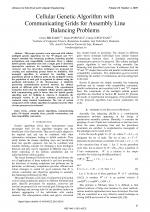| 2/2010 - 15 |
Cellular Genetic Algorithm with Communicating Grids for Assembly Line Balancing ProblemsBRUDARU, O. |
| Extra paper information in |
| Click to see author's profile in |
| Download PDF |
Author keywords
cellular genetic algorithms, communicating grids, I/U-shaped assembly lines, parallel workstations, and task compatibility constraints
References keywords
link(7), genetic(6), balancing(5), assembly(5), algorithms(5), line(4)
Blue keywords are present in both the references section and the paper title.
About this article
Date of Publication: 2010-05-31
Volume 10, Issue 2, Year 2010, On page(s): 87 - 93
ISSN: 1582-7445, e-ISSN: 1844-7600
Digital Object Identifier: 10.4316/AECE.2010.02015
Web of Science Accession Number: 000280312600015
SCOPUS ID: 77954656030
Abstract
This paper presents a new approach with cellular multigrid genetic algorithms for the I-shaped and U-shaped assembly line balancing problems, including parallel workstations and compatibility constraints. First, a cellular hybrid genetic algorithm that uses a single grid is described. Appropriate operators for mutation, hypermutation, and crossover and two devoration techniques are proposed for creating and maintaining groups based on similarity. This monogrid algorithm is extended for handling many populations placed on different grids. In the multigrid version, the population of each grid is organized in clusters using the positional information of the chromosomes. A similarity preserving communication protocol between the clusters placed on different grids is introduced. The experimental evaluation shows that the multigrid cellular genetic algorithm with communicating grids is better than the hybrid genetic algorithm used for building it, whereas it dominates the monogrid version in all cases. Absolute performance is evaluated using classical benchmarks. The role of certain components of the cellular algorithm is explained and the effect of some parameters is evaluated. |
| References | | | Cited By |
Web of Science® Times Cited: 5 [View]
View record in Web of Science® [View]
View Related Records® [View]
Updated 3 weeks, 5 days ago
SCOPUS® Times Cited: 7
View record in SCOPUS® [Free preview]
View citations in SCOPUS® [Free preview]
[1] Improvement of the Gravitational Search Algorithm by means of Low-Discrepancy Sobol Quasi Random-Number Sequence Based Initialization, ALTINOZ, O. T., YILMAZ, A. E., WEBER, G.-W., Advances in Electrical and Computer Engineering, ISSN 1582-7445, Issue 3, Volume 14, 2014.
Digital Object Identifier: 10.4316/AECE.2014.03007 [CrossRef] [Full text]
[2] A taxonomy of line balancing problems and their solutionapproaches, Battaïa, Olga, Dolgui, Alexandre, International Journal of Production Economics, ISSN 0925-5273, Issue 2, Volume 142, 2013.
Digital Object Identifier: 10.1016/j.ijpe.2012.10.020 [CrossRef]
[3] A Combined Methodology of Adaptive Neuro-Fuzzy Inference System and Genetic Algorithm for Short-term Energy Forecasting, KAMPOUROPOULOS, K., ANDRADE, F., GARCIA, A., ROMERAL, L., Advances in Electrical and Computer Engineering, ISSN 1582-7445, Issue 1, Volume 14, 2014.
Digital Object Identifier: 10.4316/AECE.2014.01002 [CrossRef] [Full text]
[4] Cellular Genetic Algorithm with Communicating Grids for a Delivery Problem, Brudaru, Octav, Vilcu, Adrian, Popovici, Diana, 2011 13th International Symposium on Symbolic and Numeric Algorithms for Scientific Computing, ISBN 978-1-4673-0207-4, 2011.
Digital Object Identifier: 10.1109/SYNASC.2011.58 [CrossRef]
[5] Multi-grid cellular genetic algorithm for optimizing variable ordering of ROBDDs, Rotaru, Cristian, Brudaru, Octav, 2012 IEEE Congress on Evolutionary Computation, ISBN 978-1-4673-1509-8, 2012.
Digital Object Identifier: 10.1109/CEC.2012.6256590 [CrossRef]
Disclaimer: All information displayed above was retrieved by using remote connections to respective databases. For the best user experience, we update all data by using background processes, and use caches in order to reduce the load on the servers we retrieve the information from. As we have no control on the availability of the database servers and sometimes the Internet connectivity may be affected, we do not guarantee the information is correct or complete. For the most accurate data, please always consult the database sites directly. Some external links require authentication or an institutional subscription.
Web of Science® is a registered trademark of Clarivate Analytics, Scopus® is a registered trademark of Elsevier B.V., other product names, company names, brand names, trademarks and logos are the property of their respective owners.
Faculty of Electrical Engineering and Computer Science
Stefan cel Mare University of Suceava, Romania
All rights reserved: Advances in Electrical and Computer Engineering is a registered trademark of the Stefan cel Mare University of Suceava. No part of this publication may be reproduced, stored in a retrieval system, photocopied, recorded or archived, without the written permission from the Editor. When authors submit their papers for publication, they agree that the copyright for their article be transferred to the Faculty of Electrical Engineering and Computer Science, Stefan cel Mare University of Suceava, Romania, if and only if the articles are accepted for publication. The copyright covers the exclusive rights to reproduce and distribute the article, including reprints and translations.
Permission for other use: The copyright owner's consent does not extend to copying for general distribution, for promotion, for creating new works, or for resale. Specific written permission must be obtained from the Editor for such copying. Direct linking to files hosted on this website is strictly prohibited.
Disclaimer: Whilst every effort is made by the publishers and editorial board to see that no inaccurate or misleading data, opinions or statements appear in this journal, they wish to make it clear that all information and opinions formulated in the articles, as well as linguistic accuracy, are the sole responsibility of the author.



